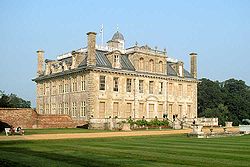Kingston Lacy
| Kingston Lacey | |
|
National Trust | |
|---|---|
 Kingston Lacy house | |
| Grid reference: | ST970021 |
| Information | |
Kingston Lacy is a country house and estate near Wimborne Minster in Dorset. From the 17th to the late 20th centuries it was the family seat of the Bankes family, who had previously resided nearby at Corfe Castle The family owned some 8,000 acres of the surrounding Dorset countryside and coastline.[1]
The house is now owned by the National Trust.
History
Kingston Lacy takes its name from its ancient lords the Lacys, Earls of Lincoln, who held it together with Shapwick and Blandford.
The Bankes family came into ownership of the estate and a great part of Dorset, having their seat at Corfe Castle. After the Civil War however, Parliament ordered that Corfe Castle be destroyed, so a new site for a home was chosen on the Lacy estate by Sir John Bankes. The house was eventually paid for and finished by his son Ralph Bankes.[1] The original house was designed by Sir Roger Pratt and was built between 1663 and 1665, with interiors influenced by Inigo Jones, but executed by his pupil, John Webb. For many years, the house was believed entirely constructed by Jones, for it so resembled his work, until the plans of Webb were discovered. It is a grade I listed building.[2]

Henry Bankes, the son of Ralph Bankes did some minor alterations in the 1820s, before he became an MP for the rotten borough of Corfe. Henry Bankes was a trustee for the British Museum and its parliamentary advocate and some of his collections, once part of the house now reside in the Museum.[1] Pitt the Younger and the Duke of Wellington once stayed at the house when entertained by Henry Bankes.[1]
The house was extensively remodelled by Sir Charles Barry, between 1835 and 1838. He faced the brick with stone, added a tall chimney to each corner, and lowered the ground level on one side, exposing the basement level and forming a new principal entrance. This work was carried out under the guide of William John Bankes, son of Henry Bankes.
William Bankes provided most of the antiquities that currently form part of the house's collections. He travelled extensively to the Middle East and the Orient, collecting the largest individual collection of Egyptian antiques in the world.[1] Most notable is the large obelisk which he brought back and which now stands prominently in the grounds of the house. He also acquired in Genoa in Italy the portrait of Maria Di Antonio Serra, by Sir Peter Paul Rubens, painted on the occasion of her marriage to Duke Nicolo Pallavicini in 1606.
The last owner of the Lacy house, Henry John Ralph Bankes, was the seven times great-grandson of the original creator Sir Ralph Bankes. Upon his death in 1981 he bequeathed the Kingston Lacy estate (including 12 working farms and Corfe Castle) to the National Trust, its largest bequest to date.[1]
Collections
On display in the house is an important collection of fine art and antiquities built up by many generations of the Bankes family. One of the rooms, the Spanish room (named by reason of the Murillo paintings which hang there), has walls hung with gilded leather. It was recently restored at a cost of several hundred thousand pounds over a 5-year period. Other important collections include paintings of the family stretching back over 400 years. Other artworks include works by Velázquez, Van Dyck, Titian and Brueghel.
Aside from the Spanish Room, the library is the most atmospheric of rooms, upon the wall of which are hung the huge keys of the destroyed Corfe Castle, handed back to Mary Bankes after her defence of Corfe Castle during the Civil War. The state bedroom is extremely ornate and has featured such important guests as Kaiser Wilhelm II who stayed with the family for a week in 1907. The main staircase is beautifully carved from stone and features three huge statues which look out onto the gardens from their seats. These depict Sir John Bankes and Lady Bankes, the defenders of Corfe Castle, and their patron, Charles I.
Within the estate are Badbury Rings, an Iron Age hill fort, and also the Roman road from Dorchester to Old Sarum. Architecturally there are several huge stone gates which stand at entrances to the Lacy estate. The house and gardens are open to the public.
Pictures
-
Kingston Lacy kitchens, washing rooms and stables
-
The house seen south west
-
The house seen from the gardens
-
The east facing side of the house
Outside links
| ("Wikimedia Commons" has material about Kingston Lacy) |
- Kingston Lacy information at the National Trust
- Kingston Lacy Garden — information on garden history
References
- Pitt-Rivers, Michael, 1968. Dorset. London: Faber & Faber.
- The Exiled Collector by Anne Sebba. Biography of William John Bankes. ISBN 0-7195-6571-5



